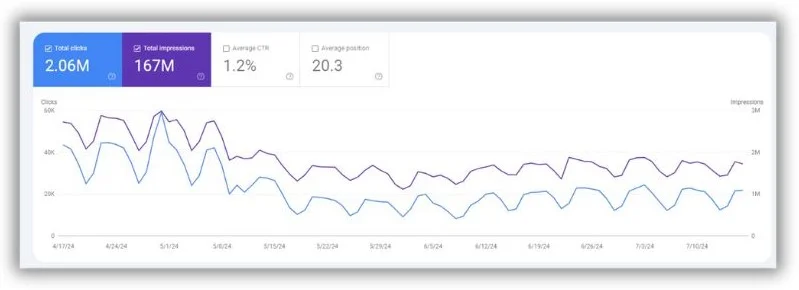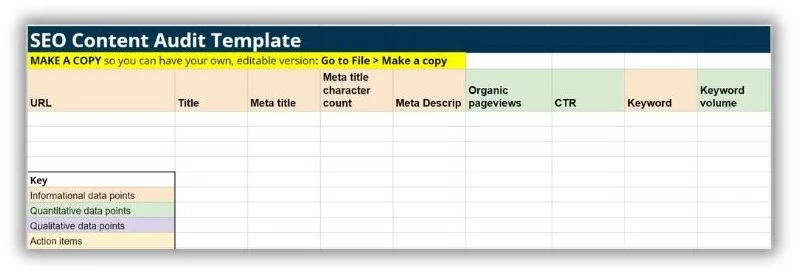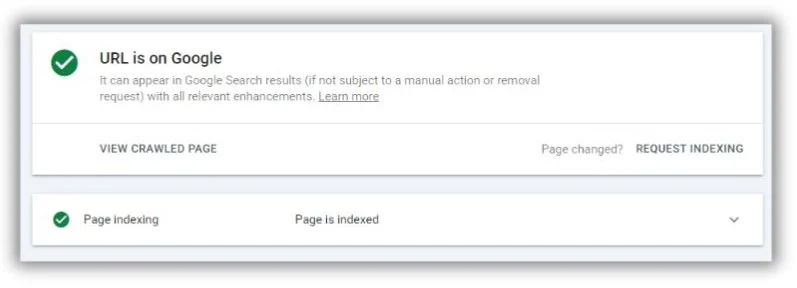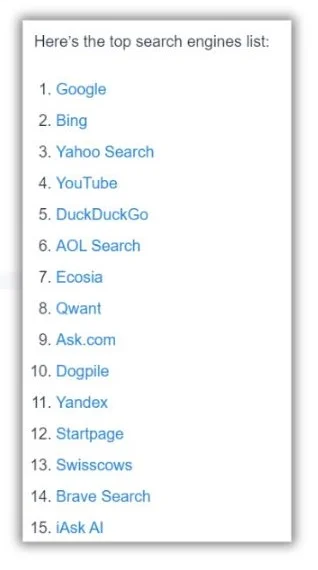
6 SEO Pros Share Tactics That Increase Traffic Now
The absolute search page chaos that followed last September’s Helpful Content Update seemed to strike indiscriminately. Several small, independent websites and institutional organizations lost half or more of their organic traffic overnight.
Since the September shakeup, I’ve seen the best marketers use a two-pronged strategy. First, they diversified their traffic sources and found new channels for non-paid website visits—a plan I believe is a long time coming.
Second, they trialed ways to work within the HCU’s new (and murky) rules to get their traffic back on track. That’s an essential step because, as much as Google frustrates me, it’s still the best source of evergreen, non-paid traffic by a big margin.
A group of marketers have already told us how they diversify their traffic sources. So, I asked several experienced SEOs and content marketers what tactics they’ve used to get content to rank since September.
They came back with six ideas that helped regain search page spots and recover organic traffic in the new Google world order. What I love best about this list is that every option is accessible to most marketers. You won’t need a 10-step technical hack to make them happen.
Contents
- Publish, review, iterate, repeat
- Prune decaying content
- Gather high-quality backlinks
- Link important pages strategically
- Prioritize authority over keyword density
- Restore visibility and improve UX
1. Publish, review, iterate, and repeat
- Previous performers: Pages that have previously performed well but are now under-performing.
- Near winners: Pages ranking for keywords in positions 6-10 and 11-20 that haven’t been updated in a while (quick wins!).
- Decaying content: Pages that have been dropping in clicks consistently.
- Poor performers: Pages with zero or close to zero clicks (don’t include fresh content you’ve recently published).
- Add expert quotes, specific examples, and data.
- Front-load key information at the top of the article.
- Re-align the content with the search intent.
- Remove any fluff (especially AI fluff, if any).
- Make the content more engaging.
- Add high-quality (but lightweight) images and videos.
- Update the meta by adding target keywords.
- Link to high-authority sites in the niche.
- Improve internal linking with your other pieces.
- Identify real-life FAQs on Reddit and answer them in your content.
- Leverage partners: “Reach out to partners who go after the same ICP [ideal customer profile] but aren’t direct competitors. Offer to create a solid article for their site in return for a link back to a focus page and keyword you want to rank for.”
- Leverage past media: “Has your exec team been featured in press, PR, articles, etc., in the past? Ask [those outlets] to add a link to one of your focus pages or amend the current link to a higher-value page (if relevant).”
- Guest podcast: “Use a site called Chartable to find niche, relevant shows. Then, pitch the hosts to be a guest. I recommend sending a short message or video on LinkedIn for your pitch.”
In the before times, what worked for one post on a blog often worked for every post. Once you found the formula that pushed your content to the top five of a search engine results page, you could apply that treatment to every post and expect most of them to perform well.
Sydney Myers, Content Marketing Manager at Jobscan, says repeatability is gone. “I’ve accepted that rankings are unpredictable and sometimes even volatile,” she said. “We could spend a month trying to create the perfect page and think it’s great, but we don’t really know how Google will rank it.”
Instead of trying to publish the perfect post upfront, she takes a ship-it-and-iterate approach. “I’ve put more emphasis on weekly performance checks and tweaks. Once a page is published, we check on it every week to see how it’s performing,” she explains. “If it doesn’t do as well as we hoped, we make adjustments.”
How it works
Sydney’s strategy is executed similarly to how most software is delivered. You produce the best version possible by a set deadline, look for bugs in real time, and update it until it does what you want it to do.
“The writers create the best page they can with the time they’re given—anywhere from a couple of days to one week,” Sydney explained. “We meet each week to review recently published content. If it’s performing as expected, we move on. If it’s not, we look at what’s ranking above it and see what tweaks we can make to improve the page.”
Sydney said they repeat the process until they’re happy. “We might make adjustments to a page for a month before it gets up to where we need.”
The menu of items Sydney’s team tries on each post will be familiar to most SEO-focused content creators. “These tweaks might be adding a new section to a blog post, rearranging the content on a page, or adding images,” she said. “Sometimes it’s things as small as changing the title, rewording headings, or updating the meta description.”
The results
The brilliance of this approach is that you’re letting the algorithm tell you what it takes to get each post to rank. “We just keep trying things to see what Google responds to. Rather than trying to predict this as we’re writing the article, we let Google tell us what works and what doesn’t,” Sydney told me.
A recent example illustrates how powerful this could be. “We had a product page that we really felt could rank number one for the target keyword,” she said. “It was top five, but we felt it could have been better. We reviewed that page every week for months, making tweaks to images, titles, internal links, and more. Finally, we got it to rank #1. It was a big win for us.”
The takeaway
Bumping your pages up the SERP, even a few spots, can make your monthly reporting much more pleasant. Backlinko recently showed that the top spot got more than double the click-through compared to the #2 and #3 positions.
You may not be able to use this tactic on everything you publish. But it’ll be a game changer for your most valuable content—the stuff that drives tons of qualified traffic or converts like crazy. For starters, try it on your product pages and product comparison posts.
🚨 Keep the ideas flowing with this guide to 130+ of the Best Online Marketing Tips for Generating More Traffic, Leads, & Sales.
2. Prune decaying content
There are billions of websites in the world. Google doesn’t have the capacity to constantly review—or crawl—every page of every site (that limitation is called a “crawl budget”). Samy Ben Sadok, Brand Ambassador & Product Advisor for Sitechecker, said it’s important to remember that limitation while tending your blog.
“Instead of focusing on new content only, prune your old content,” Samy said. “Search engines like Google hate wasting their crawl budget on irrelevant content. You want to offer only your best content so it’s sure to get indexed.”
Samy described content pruning as “removing or updating your lowest-performing content.” The idea is similar to pruning a garden. You remove the dying branches to divert resources to the healthy ones.
How it works
The first step is to find the pages that need pruning. Samy said he considers four types of content for the process:
The previous performers and near winners are candidates for updates. Here are Samy’s favorite ways to add value while updating one of those posts:
Samy added that you might also be able to update decaying content if it’s missing some of the above. Or you could merge it with another post.
But for poor performers and decaying content that can’t be brought back to speed, he says it’s time to cut your losses and remove them from your blog.
“But before removing, be sure to cross-reference those pages with a tool like Ahrefs or Semrush for any rankings or backlinks,” he said. Then, “add a permanent redirect to a topically similar page. If no similar pages are available but you want to retain authority, redirect to your blog for your articles and to the homepage for any other pages.”
That way, you don’t lose the search equity those pages have accrued, and people won’t land on a dead page if they click an old link.
The results
Removing content can have as much impact as publishing new posts. “A client had an eight-year-old ecommerce site that was never pruned,” Samy recalled. “There were 424 articles, and 60% of them weren’t bringing any clicks. I deleted around 200 articles, merged 14 together, and used the opportunity to update articles we kept to improve E-E-A-T signals.”
This year-over-year comparison shows that clicks jumped by 22% and impressions climbed by 20%, all without publishing any new content.


The takeaway
This is such a clever way to claw back lost organic traffic. It works with Google’s algorithm instead of trying to game it. Plus, it doesn’t require writing and editing new articles and guides. This should be a high priority if you have more than a few dozen posts in your blog that are more than six months old.
3. Gather high-quality backlinks
We’ve known that backlinks influence ranking for years. The recent Google leaks strongly suggest that the algorithm also heavily weighs the quality of backlinks. You can see in this snippet from the leak that links are categorized as high, medium, or low quality:


Sam Dunning founded the SaaS SEO agency Breaking B2B and hosts the Breaking B2B podcast, a top-10 B2B marketing podcast. His experience shows a direct correlation between getting high-quality links and a bump in page ranks. He shared a few cool techniques he uses to get those influential backlinks.
How it works
Sam’s approach includes three sources for backlinks that Google will love:
These are all great, but I really like the second one. It’s such a low-lift way to get extra mileage from your business’s already-existing exposure. Try a quick Google search for the high-profile people in your organization, and voila! Ready-made backlink opportunities.
As for podcast links, Sam shared a bonus tip if you, or people on your team, have been featured on several shows. “Go to the Listen Notes website. Search for your name. Then reach out to the hosts to see if any of them have relevant articles from those appearances you can get a link back from,” he said.
Results
Sam said he’s used the podcast guest strategy to help rank #1 for “b2b seo agency” and “b2b saas seo agency” within three months on a fresh domain. You’re doing something right if you can beat SEO agencies for high-value SEO keywords!
Takeaway
Backlinks are a boon and a bane for most SEOs. We know we need them, and we think paying for them isn’t great, but it can be a full-time job to get free ones. Plus, we now have corroborating evidence that low-quality links may push us back down the search engine results pages (SERPs).
Sam’s tactics make it easier to get backlinks that Google will rate highly, and that could generate referral traffic.
4. Link important pages strategically
The recent Google algorithm document leak and testimony from an antitrust lawsuit proved the importance of Navboost—a system that lets Google track and weigh user engagement when ranking content. In shorthand, getting more clicks on a page will help you rank higher on Google.
Saif Zia, Search Engine Optimization Team Lead at webAffinity, hacks Navboost with a strategic form of contextual interlinking between his highest-performing and most important pages.
How it works
With Navboost, clicks act sort of like votes, and it doesn’t matter where those clicks come from (as long as visitors don’t jump off the page immediately). Saif boosts his most important pages by linking to them from his highest-performing content.
“I start by gathering data from GSC [Google Search Console] about top-performing pages, extracting them, and utilizing them internally by linking to the home page and relevant pages,” he said.


Here’s what a blog post performance chart looks like on Google Search Console.
The idea is pretty simple. If you have a handful of very popular blog posts, you can funnel some of that traffic to the most important pages on your site with internal links. Google notes the jump in engagement, and your high-converting pages climb up the SERPs.
Saif emphasized the need for the links to make sense. They should only be added when the target and root pages have a similar context (the “contextual” part). Your anchor text also needs to describe the content it’s linking to. Otherwise, people won’t stick around on the linked page very long. That’ll hurt your SEO since Google also considers low-quality clicks negatively in its ranking regimen.
Saif also said it’s important to clear clutter and generate more link clicks through external channels. “I remove all the irrelevant content from my websites. And whatever I publish on my website, I make sure to post it on social media with a summary.”
The results
Before his strategic interlinking project, about 10% of Saif’s published pages ranked. Now, that number is around 50%. That’s a massive bump in search visibility that he said helped him increase overall traffic by 15%.
The takeaway
What I love about Saif’s strategy is that it’s so easy to do. Most of us can find our highest trafficked posts, and we know which pages would have the biggest effect on leads and conversions if they could just rank a little higher. Then it’s just a matter of dropping contextual links in. You can create a target and root page list, then drop in a dozen links a day when your brain is too tired to write.
5. Prioritize authority over keyword density
You can roughly describe Google’s algorithmic evolution in two eras. In the early days, it sought out the most relevant content—often relying on exact keyword matching to do it. In the second era, Google added filters to find the highest-quality content among the relevant results (which the recent Helpful Content Updates are tasked with doing).
Farah Ahmed, Content Marketing Strategist for ZillionDesigns, told me they’ve made a big strategy shift to meet the changing priorities of Google’s algorithm. “One of the biggest changes we have made in SEO tactics since the core update is to focus less on keyword density and more on authoritative content.”
Authority is one of Google’s core quality tenets, as described by its fun little E-E-A-T acronym (the “A” stands for authority). It’s a really good place to start upping your blog’s quality in the eyes of Google.
How it works
Farah’s strategy is to build topical authority on the blog and increase the authority of each post they publish.
“We run a thorough content audit to understand the gaps in the existing system,” She explained. “Then, we use tools like Semrush and Ahrefs to identify a handful of keywords around a subject or topic that needs to be covered.”


By way of example, here’s a screenshot from a content audit template we created.
If you want to get in the weeds of finding topical gaps in your content, this guide to competitor keyword analysis will help.
“We identify a few high-volume and less difficult keywords and integrate them into H2s and H3s only,” Farah continued. “The focus is on creating valuable content that can be linked back from other authoritative websites and generate more traffic.”
Notice that the goal isn’t to create one piece of content around one keyword. It’s to think subject-first and publish several pieces that cover different aspects of that subject. Then, interlink them so it’s easier for Google to see their connection.
💡 Our Free Keyword Tool will help you find the relevant search terms you need.
The results
“So far, we have seen great results with almost 30% to 40% of the website traffic being generated from our blog,” Farah said.
Here’s why that’s significant. ZillionDesigns is a crowdsourcing graphic design platform, so its website gets a lot of direct traffic from users starting that process. For any marketing channel to nearly equal its direct traffic (especially without paid ads) is a huge win.
The takeaway
Farah’s example reinforces the need to think bigger than one blog post at a time. Google considers the entire website, not just a single post when it weighs authority (see the section about domain authority in this article). Make it easier for web crawlers to know that you’re not a one-hit topical wonder, and you’ll start driving search traffic as Farah does.
6. Restore visibility and improve UX
Aleh Barysevich is the founder of the companies behind SEO PowerSuite (professional SEO software) and Awario (a social media monitoring app). When I asked him what’s helped his organic traffic post-HCU, he said that, first and foremost, he makes sure Google has indexed his content.
“One effective SEO tactic we’ve used after the recent Google updates involves addressing content visibility issues,” Aleh said. “First, check if Googe is indexing your content. Then, ensure all the text is being indexed.”
He also said they got a surprising boost by beefing up their posts’ UX a bit. “Another helpful hack we applied was using numbered lists across blog posts.”
How it works
Aleh said the easiest way to see if a piece of content is indexed is to search for a sentence from it on Google. You can also plug the URL into Google Search Console.


If some blog posts aren’t indexed or getting the visibility they should, it may be their length. “We’ve found that some pages with over 10K words have been hit, and reducing the content size helped restore their visibility,” Aleh added.
As for the UX tweak, that’s an easy one, too. Aleh said they added numbered lists that function like a table of contents, like from this blog post.


The list uses jump links to guide readers to different parts of a long article and gives search crawlers clear information about the post’s content.
We use jump links in most of our blog posts as well. It’s important to use descriptive anchor text (it’s usually the same as the H2s or H3s). We also use the full H2 or H3 text in the ID attribute (the bit of HTML code that connects the jump link to the section it’s jumping to).
The result
Aleh said they could get more posts indexed and on the hunt for SERP placement by shortening long posts that weren’t indexed.
As for the UX improvement, Aleh said, “Adding such lists helped our content appear in new featured snippets in Google, resulting in a 25% increase in organic impressions and clicks.”
I’d take a 25% traffic bump for an easy update any day.
The takeaway
Both of Aleh’s tactics make a lot of sense. If Google hasn’t indexed your content, how can you expect to rank and get traffic? Since SEO experts have called user experience a key focus of recent Google updates, it’s unsurprising that jump links—which make content easier to skim—would help. I’d jump on these two tactics right away.
Making the most of Google’s mayhem
Don’t lose heart if you lost traffic after Google’s helpful content update. You’re not alone, and there is hope for recovery. In addition to these six examples, I’ve seen several successful experiments documented on X and LinkedIn.
How do you move forward? Start by testing the easiest tactics first. Add jump links and strategic internal links to a bunch of high-value posts. Prune decaying content and try iterating on a few underperforming new posts weekly until they rank.
And stay tuned here. We’ll keep bringing you successful marketers’ strategies to get traffic, leads, and conversions, even as Google gets wilder.